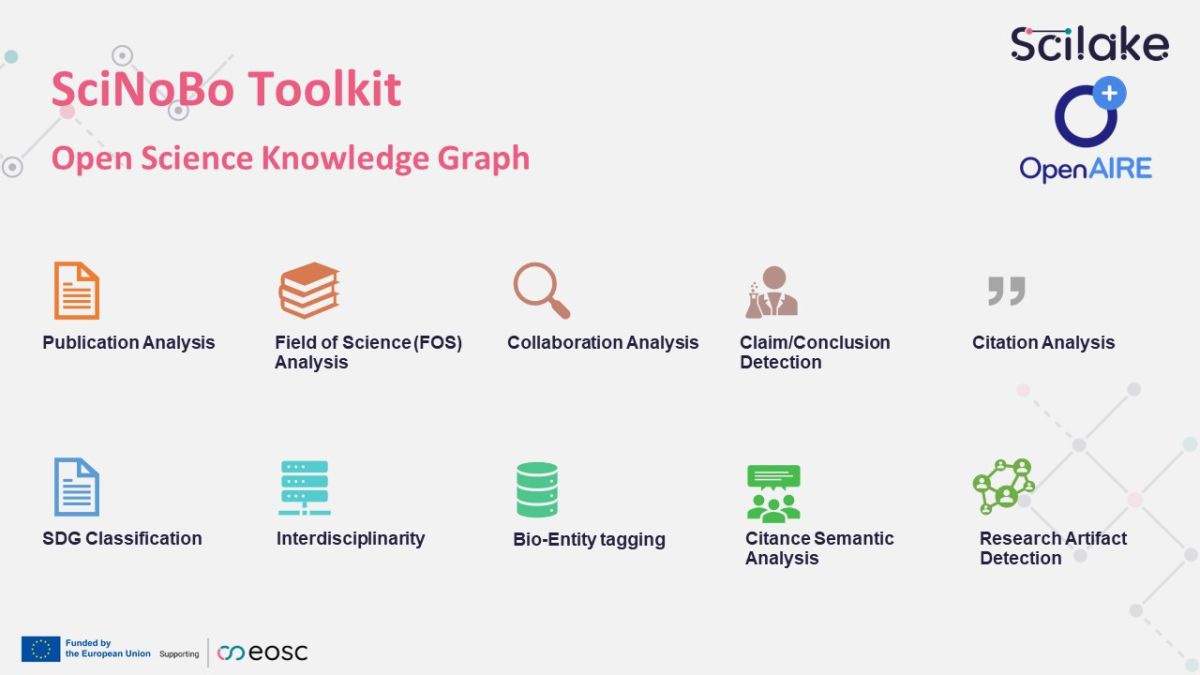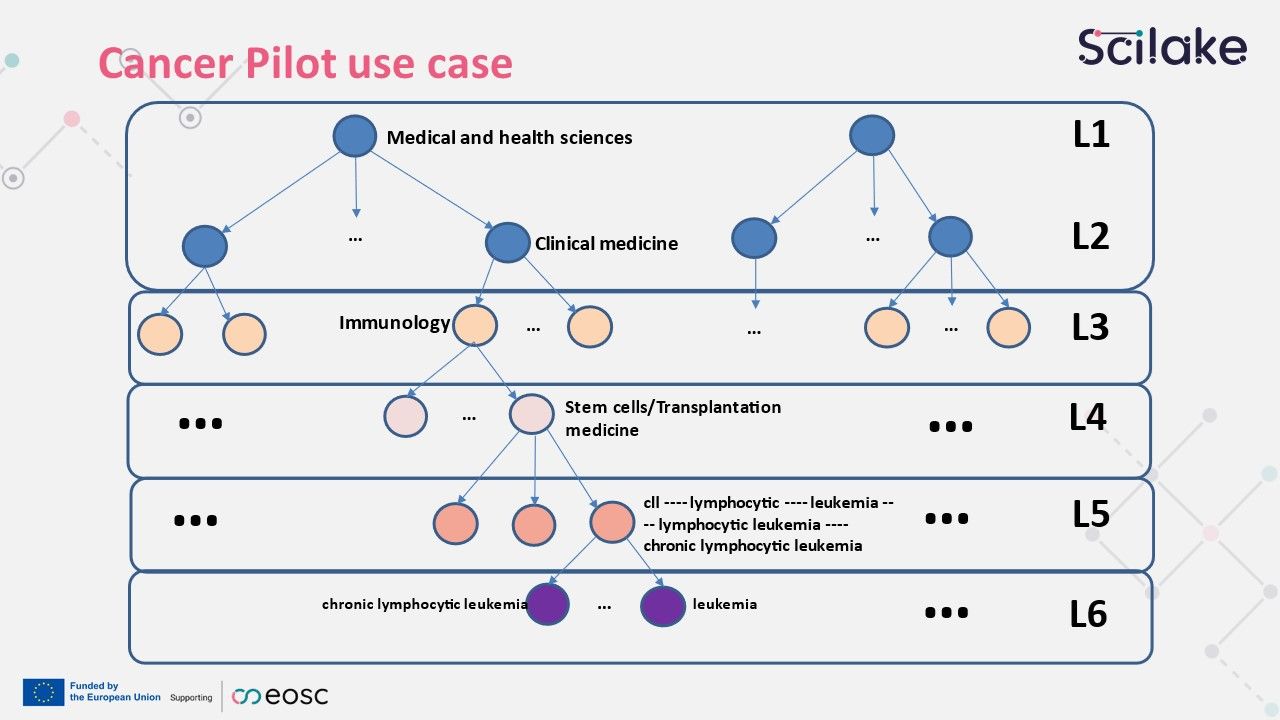SciNoBo: Science No Borders
In a recent webinar for SciLake partners, Haris Papageorgiou from Athena RC presented the SciNoBo toolkit for Open Science and discussed its benefits for science communities. SciNoBo, which stands for Science No Borders, is a powerful toolkit designed to facilitate open science practices.
In this blog post, we recap the key points from the webinar and explore the different functionalities offered by SciNoBo.

The Toolkit
The SciNoBo toolkit provides a comprehensive range of modules and functionalities to support researchers in their scientific endeavors. Let's take a closer look at each of these modules and their benefits:
-
Publication Analysis
Processes publications in PDF format and extracts valuable information such as tables, figures, text, affiliations, authors, citations, and references.
-
Field of Science (FoS) Analysis
Uses a hierarchical classifier to assign one or more labels to a publication based on its content and metadata. The hierarchical system consists of 6 levels, with the first 3 levels being standard in the literature. This approach allows to adhere to the well-established taxonomies in scientific literature while also capturing the dynamics of scientific developments at levels 5 and 6, where new topics emerge and some fade out (see image below).
-
Collaboration Analysis
Analyzes collaborations between fields and identifies multidisciplinary papers. Provides insights and indicators to help researchers understand the interdisciplinarity of a publication and joint efforts of researchers from different disciplines.
-
Claim/Conclusion Detection
Detects claims and conclusions in scientific publications, providing insights to analyze disinformation and misinformation. Helps identify if news statements are grounded in scientific terms and can collect claims and conclusions from different papers.
-
Citation Analysis
Aggregates conclusions from various sources, aiding researchers in conducting surveys on citation analysis. Facilitates a comprehensive understanding of how the scientific community adopts or builds upon previous findings.
-
SDG Classification
Categorizes publications and artifacts based on the Sustainable Development Goals (SDGs). It is a multi-label classifier that assigns multiple labels to a publication, allowing researchers to align their work with specific SDGs.
-
Interdisciplinarity
Explores research classification at various levels and highlights interdisciplinary aspects. Helps identify collaborations across different fields.
-
Bio-Entity Tagging
Extracts and annotates health publications based on bio entities like genes or proteins. Helps identify and analyze relevant biological information.
-
Citance Semantic Analysis
Analyzes statements on previous findings in a specific topic. Assesses the scientific community's adoption or expansion of these conclusions, helping researchers understand the endorsement or acceptance of previous research.
-
Research Artifact Detection
Extracts mentions and references of research artifacts from publications. The type of artifact extracted depends on the specific domain, such as software (computer science), surveys (social sciences, humanities), genes or proteins (biomedical sciences). The goal is to accurately extract all mentions and find all the metadata that coexist in the publication. From there, we can build a database or a knowledge graph that includes all of these artifacts.
Connection to SciLake Communities
The SciNoBo toolkit aims to remove barriers in the scientific community by providing a collaborative and intuitive assistant. It utilizes powerful language models and integrates with various datasets, including OpenAIRE, Semantic Scholar, and citation databases. Researchers can interact with the assistant using natural language, asking scientific questions and receiving insights from the available modules.
One of the main features of SciNoBo is its ability to help users find literature related to specific research areas or topics within a given domain. The platform provides a list of entries ranked by significance, along with their associated metadata. This allows researchers to easily access relevant publications and explore the research conducted in their field.
Once researchers have identified publications of interest, SciNoBo offers a wide range of functionalities to support their analysis. Users can explore the conclusions, methodology, and results of specific papers, and even read the full paper. The platform also enables users to analyze research artifacts mentioned in the papers, such as databases, genes, or medical ontologies. By examining the usage, citations, and related topics of these artifacts, researchers can gain a deeper understanding of the research landscape in their chosen field.
Each pilot project utilizes a different branch of the hierarchy to narrow down the publications that users may want to further analyze. Here are some examples of possible applications:
- The Cancer pilot can create a Chronic Lymphocytic Leukemia (CLL) specific knowledge graph (see image below).
- The Transportation pilot can identify publications that examine "automation" in transportation domains.
- The Energy pilot can identify publications that examine "photovoltaics" and "distributed generation".
- The Neuroscience pilot can identify publications that examine "Parkinson's disease" and "PBM treatment".

Six levels of the Field of Science classification system for the Cancer pilot use case
The platform equips researchers with the tools and functionalities to ask any type of question and receive insights based on their collected data. By using augmented retrieval technology and feeding language models with the collection of publications, SciNoBo ensures accurate and relevant results.
Furthermore, SciNoBo allows users to create their own collections of publications and save their results. This feature enables researchers to build their own knowledge graph and share their findings with the scientific community. By collaborating and expanding on each other's work, users can collectively develop a comprehensive understanding of their respective fields.
Conclusion
In conclusion, the SciNoBo platform is a valuable resource for science communities engaged in open science practices. With its wide range of tools and functionalities, researchers can explore and analyze publications, classify research fields, detect claims and conclusions, analyze citations, and classify publications. By leveraging the power of large language models and access to diverse data sources, SciNoBo provides an intuitive and immersive platform for researchers to interact with the scientific community and gain valuable insights from scientific literature.